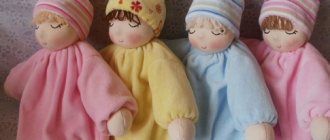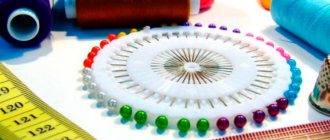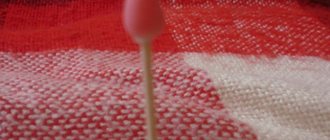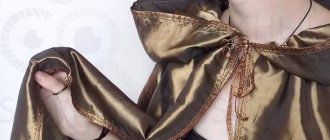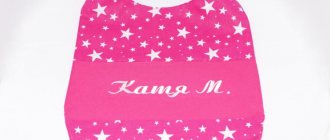Master class Children's pajamas: blouse and pants
I have long wanted to sew pajamas for my daughters myself, and the other day it happened. For pajamas in the summer, a sweatshirt is suitable, for the winter and mid-season, interlock, and warmer fabrics are also suitable for the winter, for example: fleece footer. I have interlock, soft and delicate knitwear. The fabric was provided by the online store martapillow.ru.
Free pajama pattern from the website mamashilamalishu.ru (size 68-152 cm). The pattern is suitable for both girls and boys. My daughter is 103 cm tall, I took the blouse (sweatshirt) pattern for a height of 104 cm (the size fits perfectly, there is even a small reserve), but for the panties pattern it is better to take a size larger, since this one turned out to be close to us.
So let's start with the pajama top. Cut out all the pattern pieces + 0.8 cm for the seams: front, back, 2 sleeve pieces in a mirror image. It is better to sew cuffs and neck from ribbed or cash-corse. Don't forget to transfer the marks from the pattern to the fabric.
Lay out the details of the front, back and sleeves as shown in the photo below.
Sew the sleeves to the back and front, aligning the marks. A total of 4 seams need to be made. Iron the seams. I sew pajamas using an overlocker, but you can also use an overlock stitch on a sewing machine using knitwear needles. If in this case the knitwear stretches a lot, then you can put paper under the foot of the sewing machine and stitch along it.
Then we place the front and back with the right sides on top of each other, straightening the sleeves and sewing the sleeves and the front with the back, where marked with a dotted line, making only 2 seams.
Let's move on to the cuffs. We bend the parts and sew them into a ring, where it is marked with dotted lines.
We bend the cuff parts in a circle so that the seams remain inside.
Sew the cuffs into the sleeves, aligning the marks. At the same time, stretch the cuff a little so that it coincides with the neckline of the sleeve.
Let's move on to the neck. We bend the strip in half and sew it where it is marked with a dotted line.
We bend it in a circle in the same way so that the seam remains inside.
Divide the neck of the blouse into 4 equal parts and make marks on it. We combine the facing so that the marks on it and the blouse match. The neckline facing is slightly smaller than the neckline on the blouse, so the facing needs to be stretched a little when we sew it on.
Iron the neckline, giving it a finished look.
If you want to close the seam on the back of the neck, you can proceed as follows: measure the distance between the seams at the back of the neck, add a couple of centimeters to the hem and cut a strip 3 cm wide. In my case, the size of the strip was 14x3 cm.
Sew one edge to the seam, folding the edges, as shown in the photo below.
We bend the second edge and sew it below.
Ironing. This creates a neat seam on the back.
We decorate the bottom cut of the blouse. If you don’t have a cover stitching machine, then first process the edge using an overlocker.
Then we bend the edge by 2-3 cm and sew a straight line on a sewing machine. If you have a cover stitching machine, this will make the task much easier. Iron all seams. Such clips for fixing fabric can be purchased here.
The blouse with raglan sleeves is ready.
Let's move on to the pants. I changed the pattern of the trousers a little by connecting the front and back so that there was no seam on the side. We cut out all the details of the pattern + 0.8-1 cm for the seams: 2 parts of the legs in a mirror image, 2 parts of the cuffs and a strip for the belt. It is better to sew cuffs and a belt from ribana or cash-corse.
We place both parts of the legs with their right sides on top of each other and sew the central seams where marked with a dotted line.
We place the front and back of the legs with their right sides facing each other and sew a crotch seam where marked with a dotted line.
We also sew the cuffs of the trousers into a ring and bend them in a circle so that the seams remain inside.
We sew the cuffs into the pants.
All that remains is to sew on the belt. We bend the strip for the belt in half and stitch it where it is marked with a dotted line.
We bend it in a circle so that the seam remains inside.
At this stage, you need to insert the elastic into the waistband (between the layers of fabric). The length of the elastic is usually 1-2 cm less than the circumference of the tummy, but this depends on the ductility of the elastic itself. We sew the belt to the pants, connecting the marks.
To prevent the elastic from turning over during washing, it can be sewn to the belt itself from the back, where it is marked with a dotted line.
Children's pajamas are ready.
Katerina is 4 years old.
I used the same pattern to sew pajamas for my eldest daughter. Veronica is 7 years old. I ordered Ladoshka interlock knitwear from the “1 meter of fabric” store.
And these pajamas are for my youngest daughter (made from double-thread fleece and kulirka). Katerina is 5 years old.
Another pajamas for my eldest daughter from the cooler. Veronica is 10 years old, height 146 cm.
See also: - Dress with a frill based on a sweatshirt pattern - Top/tunic for girls - Sweatshirt with a voluminous collar - Jumpsuit/fleece undershirt - Children's pants - Breeches for girls
RECOMMENDATIONS FOR THE SELECTION OF MATERIALS
For children, it is advisable to sew clothes from natural fabrics. This is especially important for pajamas, since the child wears them for a long time. Nightwear can be lighter and warmer, with or without lint, depending on the time of year.
Advice! If you plan to sew a product from natural fabric, then before starting work, treat it, that is, either treat it with a hot iron with strong steam, or wet it and let it dry. The fabric will give the necessary shrinkage, and the product will not change its size after the first wash.
Children's pajamas for boys made of flannel
Greetings to all sewing lovers! If you have small children, then you have probably bought sleepwear for them more than once. In the cool season it is especially relevant. Children's pajamas for boys made of flannel are an excellent option for such a set. In it he will feel warm and comfortable. Many of you can easily handle sewing it yourself.
A pajama suit for a boy is not very different in style from things that can be worn in everyday life, only made from other materials. Therefore, using the pattern in this lesson, you can sew both trousers and a shirt for other purposes if you wish.
This flannel pajama shirt has a classic design with notched lapels, a chest pocket and a single row of buttons. The trousers are fitted with an elastic band, which can be tightened with a drawstring if necessary. The pattern is made for a boy 116 cm tall.
RECOMMENDATIONS FOR THE SELECTION OF MATERIALS
For children, it is advisable to sew clothes from natural fabrics. This is especially important for pajamas, since the child wears them for a long time. Nightwear can be lighter and warmer, with or without lint, depending on the time of year.
Advice! If you plan to sew a product from natural fabric, then before starting work, treat it, that is, either treat it with a hot iron with strong steam, or wet it and let it dry. The fabric will give the necessary shrinkage, and the product will not change its size after the first wash.
DESCRIPTION OF WORK
1. Fold the bias strap of the chest pocket in half and stitch it to the top edge of the pocket.
2. Iron the pocket allowances to the wrong side and stitch the pocket onto the front.
3. Sew shoulder seams.
4. Glue the collar parts and stitch along the outer edges. Turn out the collar.
5. Sew the collar into the neck of the shirt.
6. Stitch bias tape over the back seam allowance of the shirt.
7. Separately cut borders, glue them with non-woven fabric, fold them right sides together with the shelves along the edges and neck edges and stitch them in place. Fasten along the shoulder sections.
8. The sleeve cuff is cut off from the pattern and cut separately on the bias. It must be folded in half with the wrong side inward and stitched to the bottom of the sleeve.
9. Sew the sleeves into the armholes of the shirt.
10. Sew the side seams on the shirt along with the seams on the sleeves.
11. Finish the bottom of the shirt and fold the seam allowance. Adjust the shirt seam allowance to fit the face.
12. Sew the back halves of the trousers to the front halves along the side and crotch seams.
13. Iron the seam allowance along the bottom of the trousers and stitch along the face.
14. Stitch both legs along the seat line.
15. Fold the waistband in half widthwise and iron. Then unfold and fold in half lengthwise. Mark the middle and 3 cm apart on one of the halves, relative to the center of the belt, sew two loops - holes for tying. Having previously duplicated them from the wrong side with pieces of material.
16. Sew the waistband along short sections, leaving a small area on the inside for threading the elastic.
17. Sew the waistband to the top edge of the trousers.
18. Thread an elastic band into the belt, grind the edges of the elastic on a machine and distribute it in the belt. During surgery, adjust the length of the tape directly on the child.
19. Iron the seam allowances of the tie to the wrong side along all edges and fold it in half and stitch it.
20. Thread into the loops on the belt using a pin.
21. Process the loops on the shirt and sew on the buttons.
Children's pajamas for a boy made of flannel are ready!
This kit is not difficult to use and even novice craftsmen can handle it. Sleepwear is always useful. In such checkered pajamas, every baby will feel like a real gentleman who has a special suit for wonderful and magical dreams.
